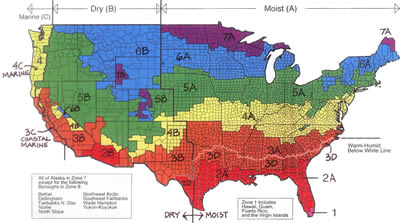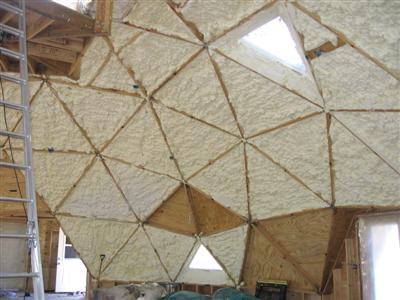The Natural Spaces Domes Building System

The Natural Spaces Domes Building System is the only dome building system specifically adapted to the 5 different climatic regions of the United States. We are long time members and supporters of EEBA, The Energy and Environmental Building Association. Their innovative, well-respected building guides are backed by years of research in four nations: Canada, Norway, Sweden and the United States. The guides were created by Building Science Corporation, applying lessons learned from the construction of the Arkansas House, The Saskatchewan Conservation House and hundreds of houses built for Canada’s R-2000 program and the U.S. Building America program.
Our involvement in over 1000 domes along with the EEBA guides has given us the information we need to adapt our dome system to the 5 major climatic regions: Cold, Warm-Dry, Warm-Moist, Hot Humid and Marine Coastal.

Most other dome building companies ignore the differences in climate. Some even say you don’t have to worry about condensation issues in colder climates. One competitor even says we don’t know what we’re talking about – all you have to do is install a heat exchange and all your problems go away. How naive can you be! Back in the early 1980’s we taught Energy Efficient Building Design 101 in the Minnesota State College System. But, we didn’t say we knew it all. We built, we learned, we listened, we researched – and we used that information to adapt our dome building system, incorporating new technology and new materials.
In our 30+ years of building dome structures, we have learned you shouldn’t build the same structure in Minnesota as you would in Houston, Texas.
Natural Spaces Domes started building a ventilated dome shell system in 1978, learning from 6 years of research, having built over two hundred fifty domes.
We saw problems with systems using materials that created vapor barriers on the exterior as well as the interior. Now we analyze climatic conditions and use “smart” vapor barriers or sometimes none at all.
We saw problems when bad building techniques were combined with waferboard, chipboard, OSB (Oriented Strandboard), Plystran and the like, allowing them to get wet. Now we only use plywood, 3/4″ to 1-1/8″ thick.
We saw problems using 2×4 or 2×6 construction limiting insulation thickness during a time when we needed to deal with the energy crisis and reduce our reliance on foreign oil. Now we use all types of insulation from fiberglass to recycled cotton to soft foam that uses American made soy bean oil.
We knew we wanted to drastically increase the energy efficiency of our dome so that it didn’t meet just the minimum code requirement for 1979 (or even 2003). Now we build 15″ to 21″ thick dome shell systems with r-values from 44 to 71.
The following is an excerpt from the EEBA Builders Guide:

The three important changes in the way we build homes today interact with each other. This is further complicated by the effects of climate and occupant lifestyle. The interrelationship of all of these factors has led to major warranty problems that include health, safety, durability, comfort and affordability concerns. Problems are occurring despite the use of good materials and good workmanship.
We cannot return to constructing drafty building enclosures without thermal insulation, without consumer amenities, and with less efficient heating and air conditioning systems. The marketplace demands sophisticated, high performance buildings operated and maintained intelligently. As such, buildings must be treated as integrated systems that address health, safety, durability, comfort and affordability.
Quality construction consists of more than good materials and good workmanship. If you do the wrong thing with good materials and good workmanship, it is still wrong. You must do the right thing with good materials and good workmanship. The purpose of the EEBA guides are to promote the use of good materials and good workmanship in a systematic way, so that all the parts work together and promote good performance, durability, comfort, health and safety in an environmentally responsible manner.
At Natural Spaces Domes, the above excerpt serves as reinforcement to our basic philosophy – Solving building and environmental issues means we have to create advanced building systems while at the same time making the house healthy, comfortable and affordable for its occupants. A Natural Spaces Dome should be designed for the next century, not the last one.
Take a look at our dome building systems. Then talk to us about where you want to build, what you want to build and how you want to live. Our Natural Spaces Dome could make your dome dreams come true in a way you never imagined.
Energy Star Dome Homes
Our Newest Energy Star Rated Dome Home:
Bear Creek Dome

49′ Diameter Mid Profile Dome
Tessa Hill and Dennis Odin Johnson – Owners
North Branch, Minnesota
More photos and info on Bear Creek Dome click here
Fiberglass insulated dome home gets a better energy rating than sprayed foam dome.

Bear Creek Dome received an independently certified rating of Energy Star 5 Plus, the highest rating. The dome has an 18″ thick dome shell, utilizing 16″ of fiberglass insulation in the dome triangles (for an R-value of 64) and 18″ of fiberglass in the riser wall (R-value of 71). The 2 level, 3200 square feet, 30′ tall dome has a radiant hot water heating system using 1500 Lineal feet of PEX tubing in the 4″ concrete slab. There is no heating system in the 1100 square feet second level and the temperature is the same as on the main floor (70° during the winter)
The H.E.R.S score (Home Energy Rating System) on our Bear Creek Dome is 57. The H.E.R.S. score on another of our domes in Iowa (shown below) was 60 (The lower the score, the better it is, energy wise)
At Bear Creek Dome, we were monitoring the temperature in 19 locations, from 7′ below grade to 15′ above the main floor. To view our special below slab heat loss test comparing 5 different types of insulation, click here.
To check on the “real time” energy costs of the Bear Creek Dome, click here.


Natural Spaces Domes are the most energy efficient domes, and we’ll continue to prove it!

A Natural Spaces Dome built by Kim and Steve Long near Perry, Iowa (30 miles NW of Des Moines) has been independently rated, energy wise. The local utility has rated The Natural Spaces Dome as an Energy Star 5 Plus, the highest rating.
The other rating is called the HERS Index, a scoring system established by the Residential Energy Services Network (RESNET) in which a home built to the specifications of the HERS Reference Home (based on the 2006 International Energy Conservation Code) scores a HERS Index of 100, while a net zero energy home scores a HERS Index of 0. The lower a home’s HERS Index, the more energy efficient it is in comparison to the HERS Reference Home.

The Natural Spaces Dome scored a 60 HERS Index which is extremely low. This means that their dome is 40% more efficient than a new conventional home built to meet the requirements of the new 2006 energy code. Kim and Steve are thrilled as one of their main reasons for building our dome in the middle of a cornfield was to achieve a tight, energy efficient home oblivious to the Midwestern prairie winds and snow. The winter of 2006/2007 will be their first and we will report on the heating and cooling costs.


Click here to see the costs of heating their dome
Natural Spaces Domes – The Leader in Energy and Resource Efficient Domes
Our Hybrid Vehicles
Not every couple has “his and her” hybrids, but they should. Dennis bought his Honda Insight in 2000 (the first year it came out). It now has over 130,000 dirt-cheap miles. A trip from North Branch, MN to St. Louis, MO averaged 63mpg at freeway speeds of 75mph. Tessa bought her 2005 Ford Escape hybrid SUV; then not available in Minnesota, she tracked one down in California. The Ford hybrid reduces “bad” emissions over 90%. With over 100,000 miles driven, the Escape averages 27-30 MPG, double the mileage of her previous SUV. (The Escape averages 30-34 mpg with predominantly city driving). In 2015 we upgraded to a Toyota Prius “V” (SUV), increasing our average MPG to the 38-45 range. Our Ford Escape Hybrid was passed down to our son-in-law. These gas/electric hybrids never need to be plugged in because they recharge themselves while driving. This is just another example of our life long commitment to alternative, energy efficient, earth-saving systems.
Bottom right photo – At 95, my dad, Odin, bought a brand new car! That might be enough news by itself except he wanted a new 2009 Ford Escape hybrid (the black one on the left). Besides the riding comfort (heated leather seats) and ease of entry in a high riding SUV, he really wanted the hybrid to save on gas and reduce pollution. In this case, like son, like father. At 99, he went to the license bureau, took off his glasses, passed the test and renewed his license for 4 more years (Odin passed away in 2013, having reached his goal of actively living to 100 years).



